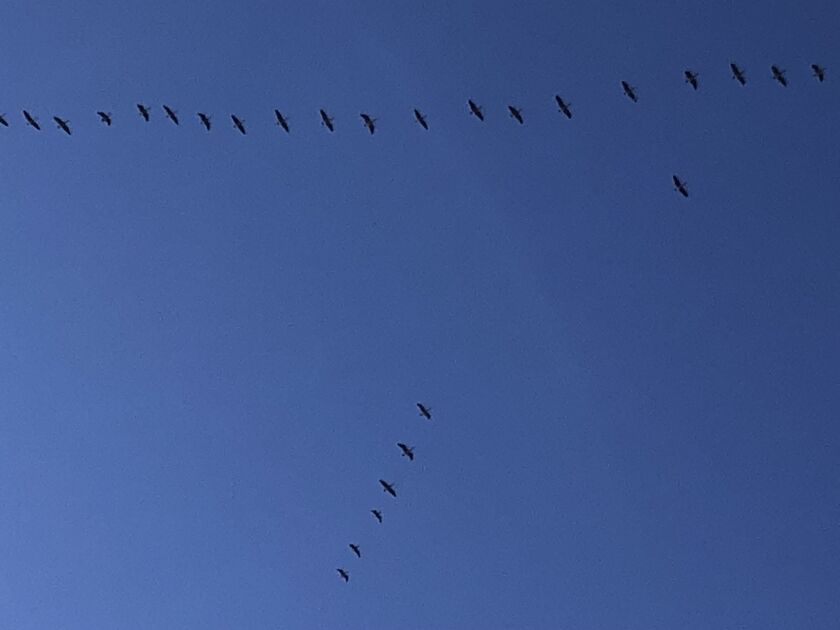A whacked-out winter: Early birds, flowers, coho, crawlers & ticks; a dearth of ice
/cdn.vox-cdn.com/uploads/chorus_asset/file/24455201/redwing02_22_23.JPG)
As I stepped out to walk Lady Tuesday, about 15 robins, first of the year for me, flitted between our maple and the neighbor’s crabapple tree.
I started checking off spring signs in my head.
What a whacked out winter.
On Jan. 19, Ron Wozny messaged a photo of daffodils and tulips popping after a few days of sun and rain. I cracked that they would be in for a rude awakening. Well, no, on Wednesday, he sent followups of them growing well.

Tulips and daffodils poking through on the Northwest Side on Jan. 19.
On a rainy Feb. 9, I found my first night crawler of the year, earliest ever, on the sidewalk during my morning ramble with Lady.
Many reported significant movement of sandhill cranes around Chicago the second weekend in February. Those reports continue from readers north, west, south and in Indiana. Over the last 20 years, sandhills became the primary indicator of seasonal change around Chicago for regular people.

Skeins of sandhill cranes headed north on Feb. 12 over Munster, Indiana.
Christian Howe had daffodils up an inch Feb. 12th. Chris Hough of LaGrange Park had crocuses popping through Feb. 13th.
Many of us saw and heard red-winged blackbirds the second week of February. I had my first of the year Feb. 14th, one of my earliest.
While compiling the Midwest Fishing Report Feb. 14th, the report from Tackle Haven in Benton Harbor, Michigan, included catching coho off the St. Joseph pier.
That’s a month early for coho that far north. I know because for the last 30 years I’ve spent the first weekend of the NCAA basketball tournament holed up at cottage south of St. Joe and it is always hit and miss whether coho will be there.
Same goes in Chicago, where coho are already being caught from shore off and on the last week or so.

Quinn Wunar with a limit of coho on the Chicago lakefront Monday.
On Monday, Alan Anderson messaged, “Early heads up, birder Tom Lally just reported he already had a deer tick on his pant leg at Axehead Lake this morning.”
Since ticks, either of our common ones, give me the willies that’s too early.
Holly Froning, master gardener and master naturalist program coordinator for Kankakee County, said it is a very tough year for maple syrup. There haven’t been many ideal days: warm days, below freezing at night. She expects spikes in maple syrup prices. The many maple syrup events the next several weeks could be challenging.
For those who live south, ice fishing has been incredibly short, as in a few days. Even in Lake and McHenry counties, ice fishing will be measured in weeks instead of months.
Limited vehicle access because of less ice drastically cut the number of shacks out for sturgeon spearing on Lake Winnebago (final numbers aren’t in yet) in Wisconsin.

This MODIS satellite image from February 12 shows below-average ice cover for this time of year on the Great Lakes.
NOAA GLERL / NOAA Great Lakes CoastWatch Node
Lack of ice has hit record lows on the Great Lakes. An article from NOAA’s research news noted, “As of February 13, 2023, only 7 percent of these five freshwater lakes was covered in ice, which is significantly below the 35-40 percent ice cover that is expected for this time of year, according to NOAA’s Great Lakes Environmental Research Laboratory (GLERL).”
More troubling, Jia Wang, ice climatologist at GLERL, found average ice cover of the Great Lakes down about 70 percent for the period Dec. 1 to April 30 between 1973 and 2017.
Some things stay on time.
I asked Steve Silic, fisheries biologist for Cook County Forest Preserves, if the mild winter would lead to early work with spawning walleye at Tampier Lake. He said no. A few younger walleye may spawn early, but most spawn based on the photo period more than temperatures.
[ad_2]
Share this news on your Fb,Twitter and Whatsapp
Times News Network:Latest News Headlines
Times News Network||Health||New York||USA News||Technology||World News